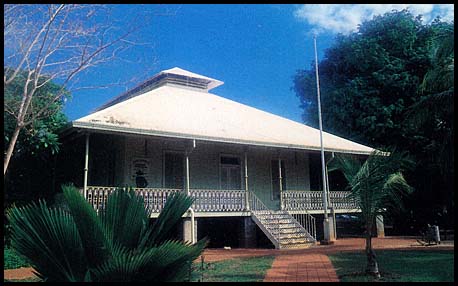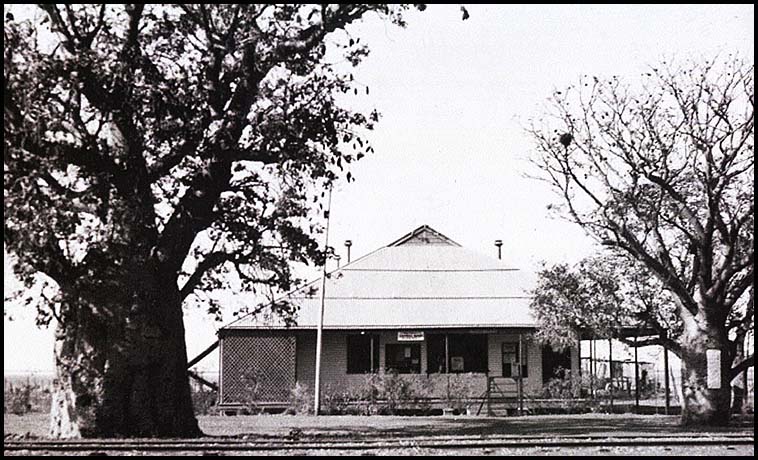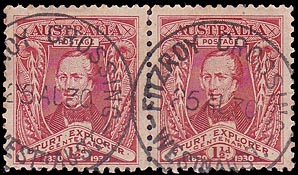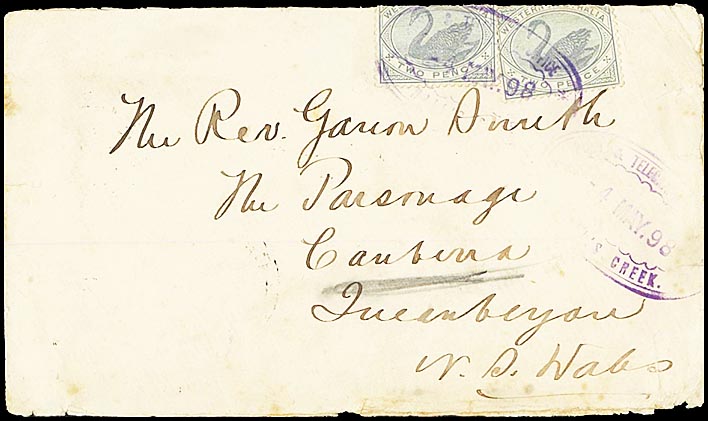Telegraph Offices in the Kimberley region.
- Australia 1901-1988
- New South Wales
- Queensland
- South Australia
- Tasmania
- Victoria
- Western Australia
- International
- Special aspects
The Kimberley region of Western Australia begins between Port Hedland and Broome and extends through Derby to Wyndham, Kununarra and Argyle and down to Fitzroy Crossing and Halls Creek. It has an area of 423,517 square kilometers (about three times the size of England or twice the size of Victoria).
The following Telegraph Offices are included in this page:
| Broome | Derby | Fitzroy Crossing | Halls Creek |
| Lagrange Bay | Roebuck Bay | Wyndham |
| Broome (Roebuck Bay).
The original point on which Broome is now located was originally called Escape Point until the Government formed a township and renamed it Roebuck Bay. There appears to have been some kind of arrangement for mails at least by 1884. The change of name to Broome was effected in 1892 and the Telegraph Office and the Post Office were combined. In November 1897, £2,600 was allocated in the Estimates for the Telegraph Office. The new Office was opened on 1 November and the first messages from the new building were despatched. The Telegraph Office - called then Cable House - opened as Roebuck Bay on 9 April 1889 to service the third Java-Australia cable. It handled the international telegraphic traffic (mainly from Western Australia with some inter-colonial messages as well) in addition to the inter-colonial Western Australia messages through the far north. NB: see also Tit Bit # 6. |
|
On Friday 29 October 1897, the Perth Daily News reported that " the new telegraph and cable station at Broome have been completed, and will be opened for business on Monday". Cable House - as the Telegraph Office was called - became redundant when the cable was closed in 1905 and the Telegraph Office was merged into the Post Office building. By 1914, Eastern Extension decided to sell Cable House. Advertisements were placed as follows (e.g. Sunday Times (Perth) 12 April 1914):
|
|
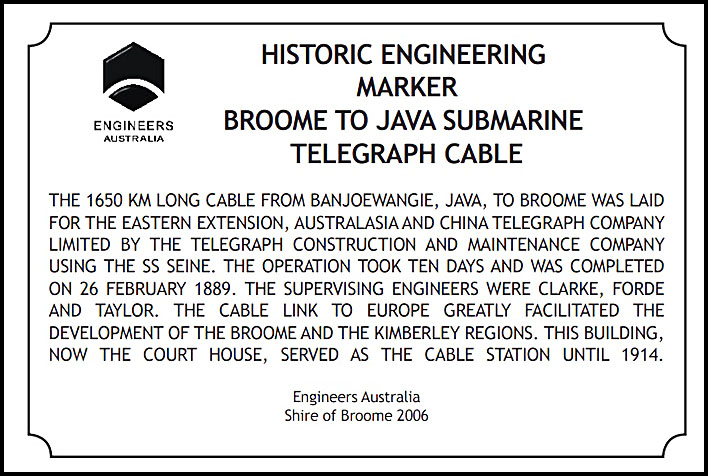 The plaque now at the Broome Court House. Commemorated by the Western Australian Division of Engineers Australia. |
|
| On 18 August 1913, a Coastal Radio Wireless Station was established at Broome. | |
Personnel: May 1894: Mr. J. Harris was appointed as Post and Telegraph Master at Broome. May 1901: Mt. M. St. J Kennedy was transferred from Perth Receiving Room to Broome. |
|
| Four types of date stamp were issued to Broome for use with telegraphs: | |
|
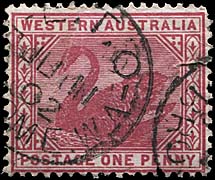 11 July 1902. |
|
| NOTE: the 1903 and 1904 date stamps omitted the 0 for the decade. | 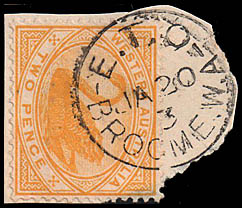 20 January 1903. |
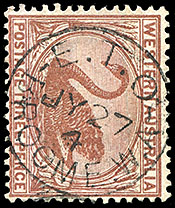 27 July 1904. |
 15 May 1908. |
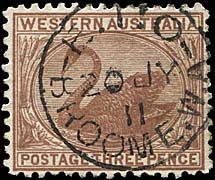 20 July 1911. |
|
|
||
|
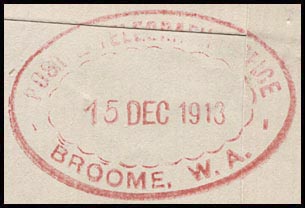 15 December 1913. |
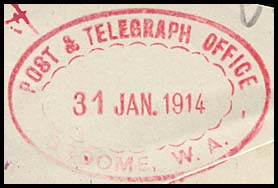 31 January 1914. |
|
|
The Post Office opened in Derby in June 1884. The construction of the telegraph line reached Derby on 18 January 1889. The Inquirer of 28 November 1888 reported: "The telegraph line is now approaching Derby fast and the work of erecting a Post and Telegraph office has already commenced. The place selected for the purpose is Wyndham Square, which is situated about midway between the Point and the present Derby township. The building is to be constructed of wood, with a stone foundation and the contractor expects to have it finished in about five weeks and to be fitted up to carry on communication as soon as the wire arrives". The Inquirer, 13 March 1889: "It is now some weeks since business was commenced in our new Post and Telegraph Office and, although the officers had some few difficulties to contend with in the beginning, the comforts which they can now avail themselves of should amply repay them for all the troubles they have had to endure, in consequence of the unfinished state in which they found things upon their arrival here. The building, which is now thoroughly completed, is composed of first class jarrah timber, erected upon a solid stone foundation, and contains eight rooms, all lined and ceiled. The business apartments are situated in the front and consist of two large rooms, well fitted up with instruments and all the appliances necessary for keeping the same in proper working order. A verandah, six feet wide, runs round the whole building, and the windows are fitted with outside shutters, which may sometimes be found very useful. Altogether it is the handsomest and most substantial place in Derby, and will certainly serve the purpose for which it is intended for many years to come, even though the attractions of Kimberley should again have the effect of drawing some few thousand inhabitants to her plains, who perhaps might not be so anxious to get away as were those of '86. A well has been sunk close to the new premises, where good water has been obtained. A pump is now attached to it and those who have to draw water will find the arrangements very much more convenient than has been the case heretofore". The combined Post & Telegraph Office was officially opened on 3 April 1889. NB: see also Tit Bit # 6. Personnel: Appointed in November 1888 but, on 19 December 1888: "I am glad to say that our little population was augmented, if only slightly, by the arrival of a few passengers by the Otway on her last trip from the South. Mr. Morley, who is about to take charge of the Post Office and Telegraph departments, was amongst the new-comers. It will be some time yet before the telegraph line is completed, but temporary premises will be occupied until the new building is ready for use" (The Inquirer). November 1888: Mr. W. E. Oliver was appointed Assistant Postmaster and Telegraph Stationmaster. January 1891: Mr. W.E. Oliver, the Assistant at Derby, was promoted to be Post and Telegraph Master at Hall's Creek. January 1893: Mr. T. E. Lloyd was appointed as Post and Telegraph Master at Derby. October 1893: Mr. J, R. Sinclair was appointed Post and Telegraph Master at Derby. 1894: Edward Geo. Worth was sadly transferred as an Assistant to the Telegraph Master at Wyndham. December 1900: Mr. Ottaway "a Telegraph Offiial" was transferred from Boorabbin to Derby. |
|
Note the train line in the front. |
|
A rubber oval Post & Telegraph Office date stamp (RO2-P&TO) was issued to the Office:
|
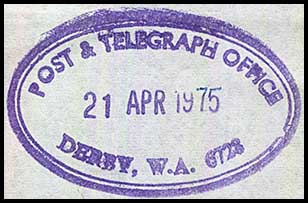 21 April 1975. |
| Fitzroy Crossing.
A Post Office called Fitzroy was opened in January 1891. It was upgraded to a Post & Telegraph Office on 1 September 1892. Fifteen years later (in 1907), the office was renamed Fitzroy Crossing. A tender was let in June 1890 to Mr. F. Feaney to construct a Telegraph Station at the Fitzroy River crossing for £1,270. Conditions were harsh in the general area of the Kimberley and personnel had to do their best especially during the rainy season. For example, the West Australian of 18 February 1895 reported "The stationmaster at Fitzroy telegraphed that communication with Hall's Creek was interrupted. Heavy rains had fallen, the creeks were overflowing. Miles of country were underwater which was rising rapidly and was all round the station. He was leaving the office for higher ground". |
|
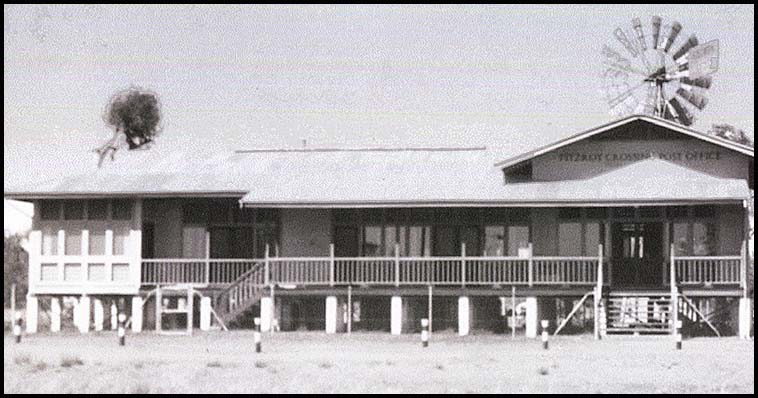 Fitzroy Crossing Post & Telegraph Office about 1950. |
|
Personnel: March 1891: Mr E. Kelly was appointed as Telegraph Linesman in Fitzroy as from 1 January. August 1894: "Mr. C. J. Annear, Post and Telegraph Master at Fitzroy Crossing, who returned to his station a few days ago after a well deserved three-months holiday, was the recipient of a very handsome illuminated address from a few of his friends on Friday evening last. The presentation was made in the large room of the Beaufort Arms Hotel by Mr. I. D. Pusey, who was unanimously chosen by the subscribers to perform the pleasant task. Mr. Pusey spoke of the sterling qualities of Mr. Annear and expressed the pleasure he felt in handing such a handsome souvenir to such an esteemed friend. It commemorated Mr. Annear's marriage and, though nominally made to him, yet the intention was dual, and the expressions of esteem it contained were to be read as applying to Mrs. Annear as well as to himself. Mr. Pusey concluded his remarks by wishing Mr. and Mrs. Annear a bright and prosperous future. The recipient, in reply, thanked his friends sincerely, on behalf of Mrs. Annear and himself, for the handsome address". 1901: Charles James Annear was appointed Telegraph Master at Fitzroy Crossing. In 1894, he had married Elizabeth Matilda Graham formerly from Eyre. She was possibly the first white woman at the Crossing. |
|
| The office was (possibly) issued with two types of rubber oval date stamp. | |
| One complication is the existence of a rubber oval Fitzroy River Telegraph Office (RO6-TO) date stamp.
This datestamp has not been previously recorded. In describing Lot 1384 of the February 2013 Prestige Philately Auction , Gary Watson writes "The earliest recorded datestamp is 'FITZROY' of 3 July 1901. So the oval date stamp (to the right here) is either an earlier Fitzroy marking or, more likely, it indicates that the office was originally called Fitzroy River".
|
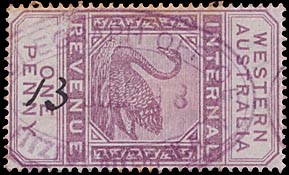 Fitzroy River Telegraph Office. RO6-TO of 13 June 1898. |
|
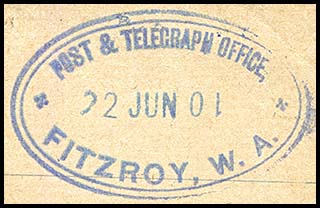 22 June 1901. Note the slug for the year is reversed. |
The usual postal date stamp for Fitzroy Crossing on a pair of 1½d Sturt commemoratives.
|
|
|
The Telegraph Line reached Hall's Creek on 6 October 1889. Tenders were called for the construction of a Telegraph Station in March 1890 with a closing date of 14 May. A Post & Telegraph Office was opened (shortly after) on 1 September 1892! A Post Office had previously been opened in March 1891. It was at Hall's Creek that, in 1885, the first Kimberley gold was discovered - by Charlie Hall. Mr. W. J. O'Donnell, the explorer, was able to shorten the route to Hall's Creek from Derby by 225 miles and shared his route with all. Personnel: January 1891: Mr. W. E. Oliver, the Assistant at Derby, was promoted to be Post and Telegraph Master at Hall's Creek (presumably still in temporary accommodation). March 1895: Mr. W. R. Oliver was transferred to became operator in charge of Onslow. Mr. R. Biederman was transferred from Roebourne to Hall's Creek to replace Mr. Oliver. |
|
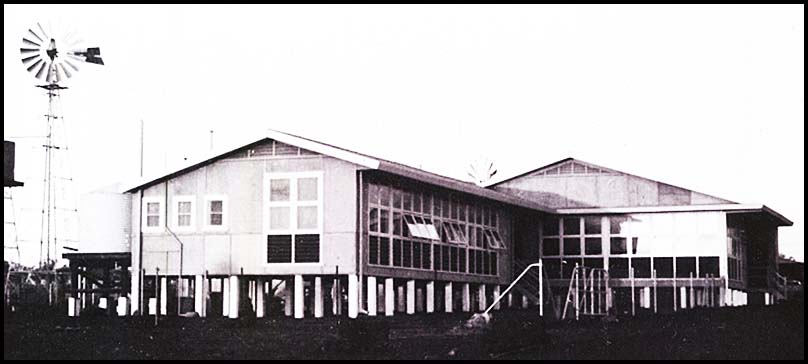 Halls Creek Post & Telegraph Office about 1950. |
|
A rubber oval Post & Telegraph Office (RO7-P&TO) was issued to the Office:
|
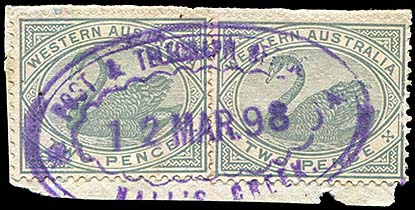 12 March 1898. |
|
|
|
A Telegraph Office was opened on 9 April 1889. Located on the north-eastern end of 80 Mile Beach. |
No special date stamp was issued to the Office for use with telegrams. Early postal date stamps were inscribed LAGRANGE without the BAY. |
|
On the line between Wyndham and Hall's Creek. A Post Office was opened on 1 July 1897 while the Post and Telegraph Office opened on 13 September 1897. Tenders were called for the construction of a Telegraph Station in March 1890. |
|
Daily News 12 March 1886: "We were officially apprised yesterday that Mr. Price, the new Government Resident at Cambridge Gulf, had selected Wyndham as the name of the new township in that district. Now the name of Wyndham was given to a township on the Kalgan River, not far from the head of Oyster Harbor, many years before Mr. Price was born. This reckless system of nomenclature is sure to give rise to much confusion in the future". A Post Office was opened in April 1887. A combined Post and Telegraph Office was opened on 17 January 1893. The following year, on Xmas Eve (according to the Australian Advertiser) a "Cock-eyed Bob" passed over the township and it did serious damage to property, especially to the police buildings. Roofs parted company with the buildings and the wood, which was totally destroyed by white ants, suffered from the blow". On 12 June 1901, a public meeting in Wyndham called for the Postmaster to replace the Post & Telegraph building in the town "as the present structure is in a state bordering upon collapse and is altogether inadequate for the requirements of the place". On 18 May 1914, a Coastal Radio Wireless Station was established at Wyndham. Personnel: November 1888: Mrs. Amy Crockett was appointed Postmaster to replace Mr. Edward WrightSame surname as the constructor of the telegraph line from Wyndham. who had resigned.. February 1893: Mr. H. W. Birch was promoted to be Post and Telegraph Master at Wyndham. 25 May 1896: A tragedy is reported from Wyndham, the details having been received by the Commissioner of Police: Dr. William Bannermann, who had been behaving in a highly eccentric manner, was observed to be flourishing a revolver in the street. When outside the telegraph office, he discharged the revolver, the shot entering the telegraph building. The telegraph station master and his assistant (Edward Geo. Worth) rushed outside as soon as they heard the report. Worth grappled with the doctor and a struggle for possession of the firearm ensued. Eventually the weapon exploded, the shot entering Worth, who fell mortally wounded and died almost immediately. A number of people congregated and Dr. Bannermann was immediately placed under arrest. An inquest was held in the afternoon by the Resident Magistrate, but no further details were elicited. Worth was a youth of 20 years, and his parents reside at Guildford. He entered the service of the Telegraph Department as a cadet and served at Guildford, Wandering and Derby, and was transferred from the last-named place to Wyndham about two years ago". Bannerman received two years hard labour for manslaughter. Sir Charles Kingsord Smith and Charles Ulm were two of Australia's great aviators. They were the first to fly across the Pacific leaving Oakland, California on 31 May 1928 in their plane the Southern Cross. They crossed Australian territory at Ballina on 9 June before flying up the coast to Brisbane. In September 1928, Kingsford Smith and Ulm made the first (successful) crossing of the Tasman to New Zealand. Some months later, they thought it would be a good idea to fly to England. They choose Wyndham for the departure spot from Australia. In May 1929, an inquiry was held into the flight. Ulm was asked "Why did you choose Wyndham as a taking off place? Ulm answered: "The first thing that directed our thoughts to Wyndham was that Kingsford Smith and I had seen the type of country round Wyndham from the air on our flight round Australia. Kingsford Smith had had considerable experience in taking off on similar types of land and that type of clay pan is similar throughout the whole west coast. It was in a good line on the route to England. 'We believe,' continued witness, 'that in the future, Wyndham will probably be one of the most important air ports in Australia when the inter-Imperial services operate. It may possibly be Derby but I still give preference to Wyndham. Darwin is definitely impossible, because machines of any size cannot be landed there. The Darwin Aerodrome is bounded on two sides by high telegraph lines and on the other side by the prison which is on the high ground. The approaches are very bad and it would cost a tremendous amount of money to make it into anything of the nature of a decent aerodrome". |
|
Two date stamps are recorded as having been issued to Wyndham for use with telegraphs:
|
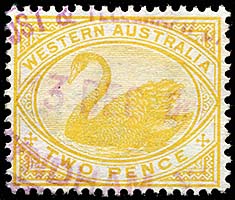 3 December ?? |
 28 September 1899. |
|
|
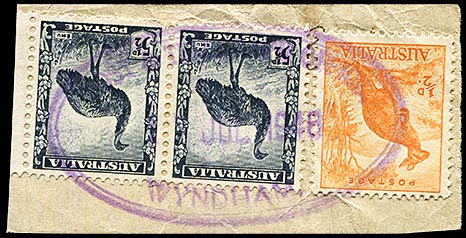 12 July 1946. |
